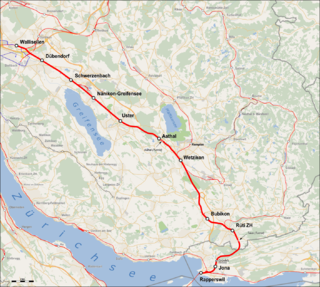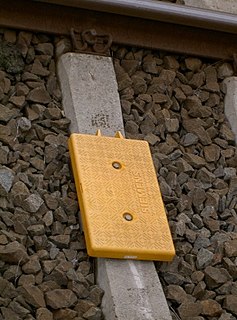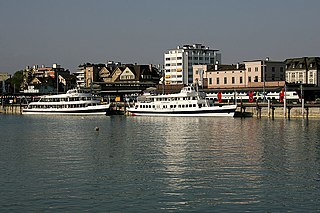Related Research Articles
Signum is Latin for "sign" and may refer to:

A balise is an electronic beacon or transponder placed between the rails of a railway as part of an automatic train protection (ATP) system. The French word balise is used to distinguish these beacons from other kinds of beacons.
A domino is a tile used in a family of games called "dominoes".

The European Train Control System (ETCS) is the signalling and control component of the European Rail Traffic Management System (ERTMS). It is a replacement for legacy train protection systems and designed to replace the many incompatible safety systems currently used by European railways. The standard was also adopted outside Europe and is an option for worldwide application. In technical terms it is a type of positive train control (PTC).

PZB or Indusi is an intermittent cab signalling system and train protection system used in Germany, Austria, Slovenia, Croatia, Romania, Israel, Serbia, on two lines in Hungary, on the Tyne and Wear Metro in the United Kingdom, and formerly on the Trillium Line in Canada.

The New Pendolino is a class of high-speed tilting trains built by Alstom Ferroviaria for Trenitalia and Cisalpino customers, derived from a model developed at the time for the Chinese operator Changchun Railway Company and subsequently developed for other railway companies, using or not the variable weight technology that characterizes this family of rolling stock.
A train protection system is a railway technical installation to ensure safe operation in the event of human error.

Integra-Signum is a Swiss train protection system introduced in 1933. Originally it was called Signum; the name Integra was added later. It transmits data inductively and is simple, robust and reliable also in snow.

The Wallisellen–Uster–Rapperswil railway line is a railway line in the Swiss canton of Zurich. It is also known as the Glatthalbahn, Glatttalbahn or Glattalbahn (Gl-TB), although the latter name is now more commonly used to refer to the Stadtbahn Glattal, a nearby light rail system.

Mechanical railway signalling installations rely on lever frames for their operation to interlock the signals, track locks and points to allow the safe operation of trains in the area the signals control. Usually located in the signal box, the levers are operated either by the signalman or the pointsman.

A Eurobalise is a specific variant of a balise being a transponder placed between the rails of a railway. These balises constitute an integral part of the European Train Control System, where they serve as "beacons" giving the exact location of a train as well as transmitting signalling information in a digital telegram to the train.
Swiss railway signalling describes the railway signalling systems used in Switzerland by the different railway companies. There are two main types of signal, used up to 160 km/h, above which speed cab signalling is required.
The first railway signalling in Greece was installed on the Athens–Piraeus Railway at the turn of the 20th century, when semaphores and boards were added with the line's electrification. Other Greek trains at that time were controlled by signals given manually by station masters. During World War II, German occupation forces installed mechanically operated semaphore signals at the entrance to all stations, with some light signals at busy stations. Modern signalling is provided through colour light signals. Radio communication between train stations and drivers was introduced in 1973 and digital communication is an ongoing present-day introduction.
The Basel Connecting Line is a railway line in the Swiss city of Basel and connects Basel Baden station on the right bank of the Rhine and Basel SBB station on the left bank. It is located on Swiss territory.

Romanshorn railway station is a railway station that serves the municipality of Romanshorn, in the canton of Thurgau, Switzerland. Opened in 1855, the station is owned and operated by SBB-CFF-FFS. It forms the junction between the Winterthur–Romanshorn railway, the Schaffhausen–Rorschach railway and the Romanshorn–Nesslau Neu St. Johann railway.

The train protection system Geschwindigkeitsüberwachung Neigetechnik enables to rise the speed of tilting trains until 30 % above the limits for conventional trains. It is installed on numerous lines in Germany along with the traditional Punktförmige Zugbeeinflussung (PZB) intermittent signalling system.

The ZUB 1xx system is a family of train protection systems produced by Siemens. Its ZUB balises were deployed in the ZUB 121 train protection system in the Swiss railway network, in the ZUB 122 tilting control system in the German railway network, and in the ZUB 123 train protection system in the Danish railway network. Some of these were adapted for other railway lines before the next generation ZUB 2xx family was introduced which is based on Eurobalises - the earlier ZUB balises are not compatible with those.

The Zürich–Winterthur railway is a Swiss railway line. It was opened in 1855 and runs from Zürich Hauptbahnhof via several routes to Winterthur and is a bottleneck in Swiss rail transport. Practically all lines of the core network of the Zürich S-Bahn use parts of this line.

The Appenzell–St. Gallen–Trogen railway, also known as the Durchmesserlinie, is a metre gauge overland tramway in the Swiss cantons of Appenzell Innerrhoden and Ausserrhoden and the city of St. Gallen. It is the steepest adhesion railway in Switzerland with a gradient of up to 8.0% and forms part of the network of the Appenzell Railways (AB) and the St. Gallen S-Bahn. The line's two branches were completed in sections between 1889 and 1904 by the St. Gallen-Gais-Appenzell-Altstätten Railway and the Trogen Railway. The two lines were connected by the AB with a cross-city route in 2018.

The hippsche Wendescheibe or Hipp’sche Wendescheibe , is a historical railway signal. The automatic and visual signal served as distant signals and home signals.